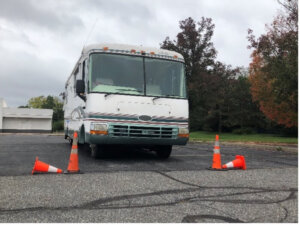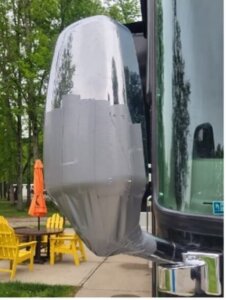By Kevin L. Vaughn
While wrapping up an inquiry about RV training with a member or prospective client, I frequently bite my tongue to avoid hearing the words I am thinking leave my lips. This is because the appropriate response from me simply sounds too cliché to not to be deemed “sales pressure.” “Pay me now or pay me later.”
The most frequent individuals to inquire about RV training come in three distinctive flavors: New buyers, Owners following a recent accident, and females from a couple where she has decided to learn how to drive in case of a potential medical emergency involving her partner. When I coordinate client training, I routinely ask several questions to ascertain the experience of the parties requesting the training. Those open-ended questions include, but are not limited to:
- Is this your first RV?
- What is your RV’s Make, Model, Length, and Year (which I use to determine the approximate value)?
- If it is a towable RV, exactly what are you towing it with?
- How much experience do you have with the tow vehicle?
- If it is a motorized RV, what if anything, do you plan to tow behind it?
- What is your experience traveling, and when was your last trip?
- Who do you travel with?
- Where will you be doing most of your RV travel?
- Where did you buy your RV, and what equipment did it come with?
My rationale is that I want to know what areas of our 12-hour training course I need to focus on or skim over based on their past experience. Sometimes, the RV was just delivered, and they have owned it for three years yet NEVER backed it up because they lacked the skill. A few inquiries come in during the shopping activity, and that is when I can really provide valuable coaching that makes them aware of dealership practices (good and bad).
However, after acquiring an RV, comprehensive RV training can potentially save your life and thousands of dollars literally down the road. Based upon the fact that most new high-quality RVs start in the low $70k range, and reach as high as $750k. Face it: at those prices, owners have made a significant investment that they do not want to experiment with. Owners typically have RV insurance with a personal deductible of $500 to $5,000, based upon the age and complexity of the RV for those “Oops” moments in subsequent years. From personal experience, there is no such thing as a “minor accident” and minimal repairs with an RV. This is due to the complex paint/decal schemes, clear coating, exterior features, and technical innovations. Replacement parts are neither cheap nor quick to obtain. The smallest damage can easily exceed $6,500 and involve 2-6 weeks of downtime.
So, if you just spent $170k for a brand-new Fifth Wheel or $650k for a Class A Diesel Pusher, what are you willing to pay at the onset to help you avoid scary situations, costly repairs, and inconvenience? When do you think is the best time to obtain RV training: before pick-up?, after the first week?, or after several months of operation? or after you have an accident? The right answer is “Before you take the first trip.” RVs are inadvertently damaged in many ways, including overhead obstructions, tail swing, off-tracking, road debris, and passing vehicles. Frankly, for new owners 90% of these causes are never even considered until something happens, even on the first day.
Just two weeks ago an RV owner I spoke to single-handedly picked up his new Class A diesel pusher valued at over $275k. He explained how he gingerly drove home solo without any issues. Upon arriving at his address, he immediately attempted to back it into his yard for storage. As I understand it, he did not have/use a spotter; he had immovable obstructions on both sides of the driveway that he was backing between, and he attempted a blindside backing maneuver. I can only guess that he had not been given any guidance for pre-setting his mirrors before leaving the dealership, and they were not aimed properly which limited his view of the RV sides. I am also assuming he was watching his backup camera which does not give a true perspective at the rear corners. The result was damage to multiple bay doors on both sides and an estimated $20K damage on Day #1.
Another client last month brought a 1998 Class A 33’ Rexhall Aerbus to training on the second day of class without a full mechanical assessment. 
Their plan for this behemoth was to travel cross-country during this summer after a few interior rehab projects. Unfortunately, as soon as we broke for lunch at noon, the monster’s radiator boiled over in the parking lot. Lucky for them they were near home and not fully packed for their adventure.
Commercial RV Driving/Towing/Operation training organizations are scarce. Some dealers offer a “free” driving “experience” just before you leave the lot like one in Seffner, FL. Shyft Group (aka. Spartan) in Charlotte, MI, offers a 2-hour driver training session during their “Spartan Academy” class. Other training courses offered such as those at rallies, have been advertised to be 1-4 hours in length without a true focus on the basics or key maneuvers that new owners must grasp. In some cases, these courses utilize an RV other than your own.

Another client who upgraded from a travel trailer to a Fifth Wheel came to us after he caved in the back window of his pickup truck when making a sharp left turn, indicating he did not have the proper fifth-wheel bed hitch enabling the trailer to slide back during cornering. This incident involved damage to both the truck and trailer nose cap.
There is frankly a small percentage of folks that contact me seeking training that have unrealistic expectations. Some inquiries for new RV training actually expect a day of training for under $200. Just this past weekend, a couple who are new owners of a travel trailer being towed by a Land Rover balked at the price tag of $1,300 for a 1.5-day training course delivered in their city over 3.5 hours away.
I hate to say, “But pay me now or pay me later.” You truly get what you pay for when it comes to operator training to drive an expensive RV. As an instructor, half of my presentation is to make owners aware of “what can possibly happen” and “how to avoid it.” For example, when emphasizing how to carefully and tactically transit through choke points (i.e., toll booth), they need to proceed extremely slowly, with the first focus being on passing both mirrors through the opening. If they break off either mirror it is significant, but a loss of the passenger mirror is catastrophic. After both mirrors clear the choke point the next objective is to ensure the sidewalls of the tires DO NOT make contact with the adjacent curbs to avoid structural damage to the body, tires, and rims.
In the photo below, I give a lot of credit to the owner’s efforts to duct the passenger mirror back in place to continue the trip.
So, to summarize my personal stance on RV training, it is absolutely a must. Owners don’t know what they don’t know. RV orientations typically cover an inadequate amount of material and features and do not touch on driving. And, one driver or operator in a couple is not enough. Having two trained drivers enables opportunities for the primary driver to rest on long straightaways and a chance to accomplish more mileage each day. But more importantly, if a medical illness or emergency arises, the second driver can swiftly take over and not be stranded due to the lack of help or cell phone coverage.
For anyone who is a new RV owner or upgrading into different level of RVs, it is a no-brainer to take the time and make an investment in training that includes not only the skills, but the know-how behind it.
Safe Travels and Jacks Up!
